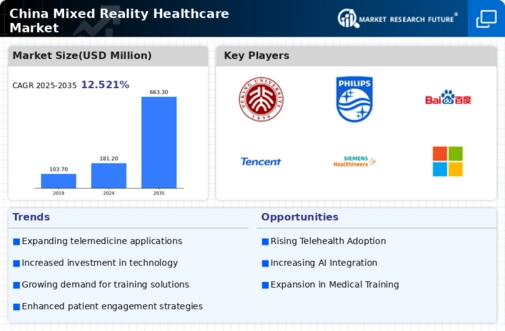Increased Investment from Private Sector
The influx of investment from the private sector into the mixed reality-healthcare market in China is noteworthy. Venture capital firms and technology companies are recognizing the potential of mixed reality applications in healthcare, leading to increased funding for startups and established companies alike. In 2025, investments in healthcare technology reached approximately $15 billion, with a significant portion directed towards mixed reality solutions. This financial backing enables the development of cutting-edge applications that enhance patient care and operational efficiency. As private sector involvement continues to grow, the mixed reality-healthcare market is likely to experience accelerated innovation and expansion.
Technological Advancements in Healthcare
The rapid evolution of technology in China is a primary driver for the mixed reality-healthcare market. Innovations in augmented reality (AR) and virtual reality (VR) are transforming medical training and patient care. For instance, the integration of AR in surgical procedures allows for real-time data visualization, enhancing precision and outcomes. The Chinese government has invested heavily in healthcare technology, with expenditures reaching approximately $200 billion in recent years. This investment fosters an environment conducive to the adoption of mixed reality solutions, which are expected to grow at a CAGR of 30% through 2027. As healthcare providers increasingly embrace these technologies, the mixed reality-healthcare market is poised for substantial growth.
Government Support and Policy Initiatives
Government support plays a crucial role in the development of the mixed reality-healthcare market in China. Policies aimed at promoting digital health technologies have been implemented, encouraging healthcare providers to adopt innovative solutions. The Chinese government has set ambitious goals to enhance healthcare infrastructure, with a focus on integrating advanced technologies. For example, the 'Healthy China 2030' initiative aims to improve healthcare accessibility and quality, which aligns with the objectives of the mixed reality-healthcare market. Financial incentives and grants for technology adoption further stimulate market growth, potentially increasing the market size by 25% over the next five years.
Rising Demand for Remote Healthcare Solutions
The increasing demand for remote healthcare solutions in China significantly influences the mixed reality-healthcare market. With a vast population and varying access to healthcare facilities, there is a pressing need for innovative solutions that bridge the gap between patients and providers. Mixed reality technologies facilitate remote consultations and training, allowing healthcare professionals to deliver services effectively. The market for telehealth services in China is projected to reach $50 billion by 2026, indicating a robust growth trajectory. This demand for remote solutions is likely to drive the adoption of mixed reality applications, enhancing the overall efficiency of healthcare delivery.
Growing Focus on Medical Education and Training
The emphasis on improving medical education and training in China serves as a significant driver for the mixed reality-healthcare market. Traditional training methods often lack the immersive experience necessary for effective learning. Mixed reality technologies provide realistic simulations that enhance the educational experience for medical students and professionals. Institutions are increasingly adopting these technologies to improve surgical skills and patient interaction techniques. The market for medical training solutions is expected to grow by 20% annually, reflecting the increasing recognition of the benefits of mixed reality in education. This trend is likely to bolster the mixed reality-healthcare market as educational institutions seek innovative training methods.





















Leave a Comment